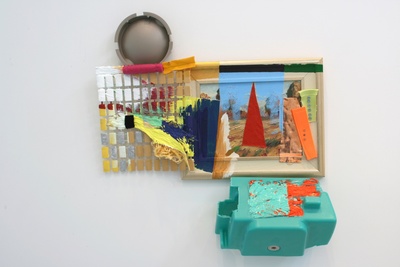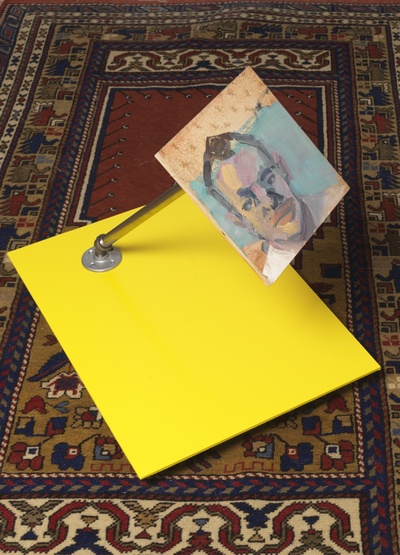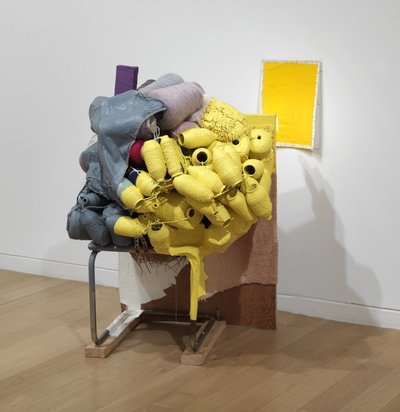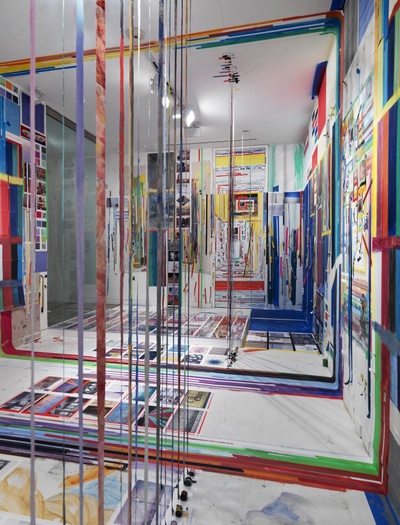Paint Things: Beyond The Stretcher
Through April 21, 2013
deCordova Sculpture Park and Museum
Lincoln, MA
Like many intersections, the intersection of painting and sculpture can be approached via many avenues, recast in deliberate contemporary terms as an edgy departure from the canvas or perhaps more sensibly in an historical sense as an ongoing process of exploration. This, of course, ignores the broader human impulse simply to decorate and alter the shit out of anything they can get their hands on (not, we are reminded, a uniquely artistic urge). One needs only to recall (perhaps imprecisely) the original jarring colors of ancient Greek temples, or the elegant simplicity of the pyramids at Giza draped in white paint to remember the strength of this impulse. More formally, it would be easy enough to look back to the combines of Rauschenberg as a beginning of sorts. And just as quickly, in this path, an astute art historian would point you further back again in time.

Sarah Cain, killing me softly, 2013, installation view, mixed media, dimensions variable, Courtesy of the artist and Honor Fraser, Los Angeles, CA, Galerie LeLong, New York, NY, and Anthony Meier Fine Arts, San Francisco, CA. Photo: Clements Photography & Design, Boston.
Also in view: Sarah Braman, 8pm, 2011, camper chunk, steel, Plexiglas, and paint, 41 ½ x 52 x 48 inches, Collection of Mr. James Keith Brown & Mr. Eric Diefenbach; and Jessica Stockholder, [JS 462],2008, framed oil painting from TJ Maxx, green plastic, brown plastic, bamboo bead mat, yarn, cloth, copper, plastic bits, thread, lexel caulk, oil and acrylic paint, hardware, 29 x 27 x 8 inches, Courtesy of Anne & Joel Ehrenkranz.
Using the seminal essay by Rosalind Krauss, “Sculpture in the Expanded Field” (October, Vol. 8: Spring, 1979, 30-44) to gather herself a toehold, deCordova exhibition co-curator Dina Deitsch tightly weaves together the various (and unruly) strands of merging art practices to craft one of the catalogue essays that accompany the show. It is a deft and useful companion to an exhibition that moves with ease through, for some, unfamiliar and arbitrary territory.
As Deitsch so aptly states, “The artists collected in this exhibition paint things. They literally paint things. And by doing so they welcome the notion of the Thing—the object—into the realm of the image and, in the modernist language of a painting, into the flatness that is a painting’s historical hallmark. “ This increasingly heated oscillation between the two mediums of painting and sculpture grapples less with answers but rather more with questions, some of which are deliberately pointed and profoundly obscure.

Jessica Stockholder, [js 462], 2008, framed oil painting from TJ Maxx, green plastic, brown plastic, bamboo bead mat,
yarn, cloth, copper, plastic bits, thread, lexel caulk, oil and acrylic paint, hardware, 29 x 27 x 8 inches, Courtesy of Anne & Joel Ehrenkranz.
What is it, after all, this hybrid approach to this so-called painted thing? Materially speaking, it could be anything and indeed everything. Alex Da Corte, in the construction of his work Blood Brothers, uses metal grids, enamel, a porcelain cat, Jelly Belly blueberry air freshener, a shoe tree, and a blank CD, among other things, to fashion the gestures and mark making that you would find in a traditional painting, with the metal grid a stand-in for a canvas. What results is the savvy blurring of medium-based distinctions.
Jessica Stockholder, like Da Corte, takes the kitchen-sink approach to constructing her work. Her ready-made toolbox includes things purchased from stores like TJ Maxx, including, famously, paintings. Stockholder subverts the notion of a starting point and instead creates elegant debris fields that flow across each other as daubs of paints litigate any questions of cohesion. In (JS 462), 2008, plastic, yarn, and bamboo (again, among other materials) solidly settle in place despite the unexpectedness of their arrangement. For Stockholder, authorship is an open-ended question, one where the origin of materials is decidedly unclear, or perhaps more to the point, simply unimportant.

Steve Locke, you don’t deserve me, 2009-2012, painting: oil and collage on beveled panel, spray painted on rear (10 x 10 inches),
pole: stripped steel pole, and floor flanges (1/2 inch diameter, overall length 18 inches), base: enamel on panel with spray paint on bottom
(16 x 20 x1 1/2 inches with beveled top), Turkish prayer rug. Courtesy of the artist and Samson Projects, Boston, MA.
One of the works by Steve Locke included in the show is called you don’t deserve me, 2009-12. It is a painting, oil and collage, of a face, attached by a pole to a base, which is placed over a Turkish prayer rug. The pole situates the painting among other works rather than stranding it on, say a wall. The painting, in the best sense of the word, is on the make. It is ready to engage and poised, despite being securely tethered to its base, to swing out into the world. This, even as the title indicates, with the knowledge that sometimes this type of openness rewards us less than taking a more guarded approach with our interactions. What Locke’s work suggests is that the turmoil of uncertainty has its own cunning beauty.
Sarah Cain’s large-scale installation Untitled, 2013, explodes across the museum walls before flowing out onto the floor, before exhausting itself in front of a white bench, almost insisting on more room to expand. In an ironic twist, Cain paints the museum setting, using the very architecture designed to show art as a basis for the art itself.

Jessica Stockholder, Kissing the Wall #5 with Yellow, 1990, metal strapping, spools of thread and wool, plastic cord, cloth,
wood chair, oil and latex and acrylic paint, fluorescent light, paper, glue, 30 x 36 x 54 inches, Courtesy of The Carol and Arthur Goldberg Collection.
Photo: Clements Photography & Design, Boston.
Franklin Evans’s work was one of the highlights of last year’s Art Basel Miami, but here his installation paintthinks, 2013, feels constrained and oddly disjointed. Perhaps it is the setting (a room off the main staircase) that tampers with the overall effect. Yet one can’t help but feel somewhat overwhelmed by the amount of information on display, which includes a Plexiglas-covered bookcase on the floor that can be walked over while you study the titles on the spines of the books. Evans might have needed more room to unspool his visual narratives or simply edit them down somewhat better to utilize the size of the gallery space made available to him—a small thing, perhaps, because Evans’s makeshift approach and tape-laced work is wholly compelling otherwise.
The deCordova gathered eighteen artists for Paint Things and the assemblage of work is a smartly executed foray into the blurred and frenzied and ever-shifting world of contemporary practices. Looking backward in time, too, the exhibition pays homage, directly and indirectly, to the work of a host of artists whose presence is keenly felt, making the balance struck seem remarkably current.

Franklin Evans, paintthinks, 2013, acrylic on canvas, digital prints, laminations, photographic sculpture,
painted tape, wall painting, sound piece, Courtesy the artist and Federico Luger, Milan. Photo: Clements Photography & Design, Boston.
Robert Moeller is a painter and writer and the website coordinator of artnewengland online.
